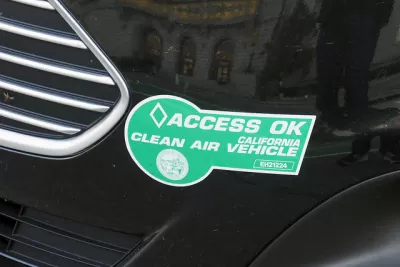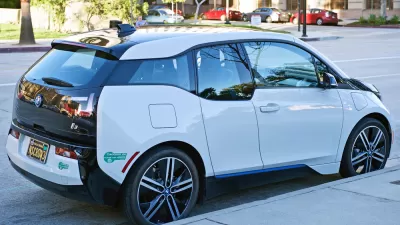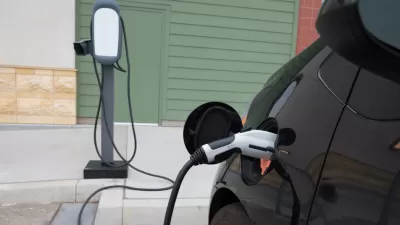The Los Angeles Times editorialized in support of legislation that is expected to be introduced next year to ban sales of internal combustion engine passenger vehicles, though they didn't suggest a date when the ban should become effective.

"It has become clear that the free market is not working fast enough to wean us from our dependence on fossil fuels to power our cars and trucks, which account for more than 10% of man-made greenhouse gas emissions," writes the editorial staff on Nov. 1. They are downplaying the contribution of transportation emissions in California, though, where it is responsible for 39 percent of greenhouse gas emissions according to the Air Resources Board's California Greenhouse Gas Emission Inventory - 2017 Edition released last June (and posted here).
Even as temperatures rise year after year, and as the nation gets victimized by more and larger hurricanes, droughts and wildfires, consumers buy ever more gas-guzzling SUVs and pickup trucks and put in more miles on the road.
Emissions feebate alternative
There are market-based ways to increase sales of fuel-efficient and zero emission vehicles (ZEVs) and reduce sales of gas-guzzling SUVs. Emission feebates, used by the Netherlands, United Kingdom and Singapore, was studied by the University of California (Berkeley, Davis, and Irvine campuses) for the California Air Resources Board in 2010.
These programs add a surcharge to guzzlers and award low and/or zero-emission vehicles a rebate. However, many European and Asian nations have recently adopted or advanced policies to ban internal combustion engine (ICE) passenger vehicle sales by targeted dates:
- Netherlands: 2025
- Norway: 2025
- India: 2030
- Germany: 2030
- France: 2040
- Great Britain: 2040
- China (uncertain)
Auto manufacturers have taken notice of the movement away from petroleum. Volvo was the first to announce the shift toward electric vehicles (EVs) last July, and even General Motors has jumped on board, reported Alex Davies, Wired's transportation reporter, last month.
General Motors believes the future is all-electric,” says Mark Reuss, the company’s head of product. “We are far along in our plan to lead the way to that future world.”
Setting a target date to enact the sales ban
"Is 2030 the right deadline? Or 2040? Or sooner?" asks the editorial board. "We’ll leave that to the experts, though the goal must be to get us there as quickly as is reasonable."
Assemblyman Phil Ting (D-San Francisco), a clean energy advocate, has set a date, 2040, in legislation he plans to introduce when the legislature reconvenes in January, reports Rob Nikolewski, energy reporter for The San Diego Union-Tribune on Oct. 27, though the specifics haven't been written yet.
According to a post last month, the legislation could have the support of Gov. Jerry Brown who has eyed the overseas ICE bans and wondered, "why not California?"
Long ways to go
"About 2 million new cars are sold each year in the Golden State but only about 5 percent meet the state government’s definition of a zero-emission vehicle, adds Nikolewski.
Gov. Jerry Brown has set a goal of 1.5 million clean-energy vehicles on California’s roads by 2025. A little more than 334,000 have been sold in the state thus far.
Ting's current bill
A Ting-authored bill introduced this year, Assembly Bill 1184, would have dramatically increased the rebate amount for eligible electric vehicles by drawing disproportionately from the state's cap-and-trade revenue. It passed the Assembly this year and "will be taken back up in the upcoming session," notes Nikolewski.
FULL STORY: Editorial: If California insists on keeping its car culture alive, it needs to do so without fossil fuels

Alabama: Trump Terminates Settlements for Black Communities Harmed By Raw Sewage
Trump deemed the landmark civil rights agreement “illegal DEI and environmental justice policy.”

Study: Maui’s Plan to Convert Vacation Rentals to Long-Term Housing Could Cause Nearly $1 Billion Economic Loss
The plan would reduce visitor accommodation by 25% resulting in 1,900 jobs lost.

Why Should We Subsidize Public Transportation?
Many public transit agencies face financial stress due to rising costs, declining fare revenue, and declining subsidies. Transit advocates must provide a strong business case for increasing public transit funding.

Paris Bike Boom Leads to Steep Drop in Air Pollution
The French city’s air quality has improved dramatically in the past 20 years, coinciding with a growth in cycling.

Why Housing Costs More to Build in California Than in Texas
Hard costs like labor and materials combined with ‘soft’ costs such as permitting make building in the San Francisco Bay Area almost three times as costly as in Texas cities.

San Diego County Sees a Rise in Urban Coyotes
San Diego County experiences a rise in urban coyotes, as sightings become prevalent throughout its urban neighbourhoods and surrounding areas.
Urban Design for Planners 1: Software Tools
This six-course series explores essential urban design concepts using open source software and equips planners with the tools they need to participate fully in the urban design process.
Planning for Universal Design
Learn the tools for implementing Universal Design in planning regulations.
Smith Gee Studio
Alamo Area Metropolitan Planning Organization
City of Santa Clarita
Institute for Housing and Urban Development Studies (IHS)
City of Grandview
Harvard GSD Executive Education
Toledo-Lucas County Plan Commissions
Salt Lake City
NYU Wagner Graduate School of Public Service





























